The end of the world is never really the end of the world—at least not in fiction. After all, someone must survive to tell the tale. And what tales they are. Humans have been pondering the end of existence for as long as we’ve been aware of it (probably, I mean, I wasn’t there), and as a result we have a rich collection of apocalypse and post-apocalypse literature to read during our planet’s senescence.
I’ve done my best to limit this list to books in which there is—or has been—some kind of literal apocalypse, excluding dystopias (like The Handmaid’s Tale) or simply bleak visions of the future. We could argue all day about what actually constitutes an “apocalypse”—2020 is checking a lot of boxes, as you may have noticed—so for the most part, I’ve gone with my gut.
Of course, there are plenty more great apocalypse and post-apocalypse novels that didn’t fit on this list, and I haven’t read enough books in translation in this genre, so as ever, please add on your own favorites in the comments.
(And stay safe out there.)

John Wyndham, The Day of the Triffids (1951)
It feels mildly ridiculous now—or maybe just mild—but Wyndham’s killer-plant-cum-blindness-inducing-meteor-strike apocalypse is a classic for a reason: it’s terrific fun. Even Arthur C. Clarke called it an “immortal story.” And it’s not quite as well-known, but allow me to slide in his 1955 novel The Chrysalids here too, as a b-side.

Richard Matheson, I Am Legend (1954)
At this point, Matheson’s pandemic/vampire/zombie novel is more famous for being source material than for being actual material, probably because it is overflowing with ideas. It is sometimes awesome and sometimes boring; jury’s still out on whether it really works as a novel, but it absolutely gets points for influence. And verve.

Emily St. John Mandel, Station Eleven (2014)
Your favorite novel in which a flu pandemic wipes out civilization in a matter of weeks (yikes) and a band of entertainers wander the decimated land, putting on Shakespeare plays for the survivors. It’s about as feel-good as stories about the apocalypse get.
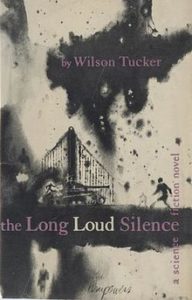
Wilson Tucker, The Long Loud Silence (1952)
Everything east of the Mississippi has been destroyed by a nuclear attack; the scant survivors have been dosed with a bioweapon that has infected them with the plague (just to be safe, I suppose). A military border is set up along the river to keep the sickness from spreading west, but this is a border that Gary is determined to cross. Particularly strange and sad reading for a nation in quarantine—and proof that breaking it can bring disastrous effects.
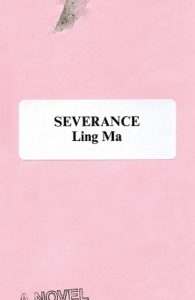
Ling Ma, Severance (2018)
The plague that ends the world in Ma’s excellent debut is extra scary because we’re all halfway there: when you catch Shen Fever, you continue going about your routine, doing your rote tasks, not that much more of a zombie than you were in life, until eventually you rot away. Is Shen Fever actually just weaponized nostalgia? Or comfort? Whatever it is, Candace is one of the few who finds herself immune, and documenting New York City as it crumbles around her until even she is forced to flee.

David Mitchell, Cloud Atlas (2004)
Of course Cloud Atlas is not entirely a novel about the end of the world, and in fact of its six storylines only one could be considered post-apocalyptic (one other is squarely dystopian). But considering the novel’s insistence on the interconnectedness of time and space (and people) and the centrality of the post-apocalypse it does evoke (located at the pinnacle of the novel’s unique structure), I think it’s only fair to count it here.

Nevil Shute, On the Beach (1957)
It is 1963, and a nuclear war has devastated most of the planet. In Melbourne, relatively untouched, a handful of survivors wait for the winds to bring the radiation to their shore, occupying themselves more or less usefully, if such a thing can be said to have any meaning at the end of the world, as others investigate what may be a message from a survivor in Seattle. A moving, if not particularly scientifically sound, classic.
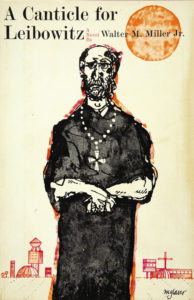
Walter M. Miller, Jr., A Canticle for Leibowitz (1960)
After civilization has been mostly wiped out by nuclear war, the few survivors become dedicated Luddites, purging themselves of all knowledge and eliminating any who would share or spread it. The only people trusted with science are the monks in the Albertian Order of Leibowitz, who have pledged to protect it until humanity is ready for it again. The novel spans several thousand years, and the moral is: we’ll always destroy the earth no matter how many precautions our ancestors took. Oh well.

Tatyana Tolstaya, tr. Jamey Gambrell, The Slynx (2000)
It’s two hundred years after “the Blast,” and in Moscow the snow is always falling. Benedikt is just glad not to have any major mutations, and a job, which is to transcribe the “speeches” of the wasteland’s leader, which are actually plagiarized from old books, not a single one of which Benedikt has ever read. Until, that is, he meets the Oldeners, whose secret libraries will change everything for him.

Nnedi Okorafor, Who Fears Death (2010)
Truly a fantasy novel (if these genre distinctions matter, which they don’t), but set in a post-apocalyptic Sudan into which Onyesonwu is born, a child of rape and genocide, and hones her magical powers until she can strike back against her father. A striking, grand novel that everyone should read.

Hanna Jameson, The Last (2019)
We often think of the apocalypse as something that happens to everybody at the same time—but what about those in remote locales that remain untouched at the beginning? In this novel, the world ends while Jon is at a Swiss hotel, far away from everyone he knows and loves. So what does he do? Get busy solving the more immediate problem: the dead body on the premises. Of course.

Colson Whitehead, Zone One (2011)
The preeminent modern literary zombie novel, in which everyone left in Manhattan is either a zombie, feral skels or morose stragglers, or a human suffering from PASD (post-apocalyptic stress disorder) and our mediocre hero is one of the band sent to clear out the stragglers. A zombie novel for people who don’t read zombie novels and a literary novel for people who don’t read literary novels.

J. G. Ballard, The Drowned World (1962)
My favorite Ballard: a heady quasi-adventure novel set in a future in which the entire planet has been transformed into a series of sweltering lagoons, a neo-Triassic landscape that horrifies and also transfixes the survivors, who are plagued by dreams and strange impulses.

Margaret Atwood, Oryx and Crake (2003)
You may argue that The Handmaid’s Tale is just as much of an apocalypse novel as Oryx and Crake, and in some ways I’d agree with you—an apocalypse of mind and morality instead of body and planet. But you know and I both know what we’re doing here. Plus, Oryx and Crake, while somewhat less celebrated, is just as good, a frighteningly plausible world destroyed by our relentless pursuit for happiness in a bottle. Oh, and trusting corporations. Of course.

Rumaan Alam, Leave the World Behind (2020)
Alam’s recent blockbuster hit slash literary darling has what may be the quietest apocalypse on this list, at least from our viewpoint. We see almost nothing, get only hints of the destruction that descends on the world, and instead are focused on the increasing anxiety of two families, thrown together by chance, as they try to make sense of what is happening. Which . . . is probably how most of us will experience the apocalypse, when it comes. Knowing this fact makes the novel all the more chilling.
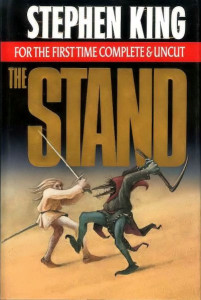
Stephen King, The Stand (1978)
A classic, and probably King’s best novel (don’t come for me) is a behemoth (famously inspired by The Lord of the Rings) with many threads and characters, all set in a world ravaged by a pandemic caused by a weaponized strain of influenza that is fatal to 99.4% of those who encounter it. So you may not want to read it right now!

David Markson, Wittgenstein’s Mistress (1988)
This is not usually discussed as a post-apocalyptic novel, and indeed it depends on how you read it, but let me present my case: if you take the narrator’s word for it, she is the last woman alive on earth, typing along to keep herself occupied, with no hope of ever encountering another soul again. So something must have happened. The problem is: can you take the narrator’s word for it? Either way, the novel takes up the same themes as many of the others on this list, albeit in its own experimental, literary fashion: what is left when nothing is left? How should the survivors live? What did our art, our science, or civilization mean? Did it mean anything at all?

Cormac McCarthy, The Road (2006)
The very first novel you (probably) think of when someone says “post-apocalyptic,” in which a man and his son travel across a blasted-out country that ever gets explained. Weirdly punctuated, unforgettable, and something of a departure for McCarthy—except in its unyielding bleakness.

Octavia Butler, Parable of the Sower (1993)
The best and worst thing about this novel is how close it feels to being possible (it is set four years from now). Unchecked climate change, wealth inequality, and corrupt leadership have destroyed society for most people—who now live in guarded settlements or scavenge in roving bands—and the hot new drug that makes you into an arsonist is just an extra fun detail. Of course our narrator is afflicted with the worst possible thing you could have in such a scenario, and also the thing that might save everyone: hyperempathy, meaning she feels the pain of others. A literary page-turner of the highest order.
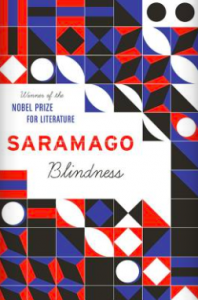
José Saramago, tr. Giovanni Pontiero, Blindness (1995; English publication 1997)
It doesn’t take a meteor or a nuclear missile to destroy civilization; all you need is a surprise epidemic of blindness, and men and women will destroy it themselves. Despite the compelling, experimental prose, parts of this feel like a horror novel, but unlike most of the books on this list, it ends on a note of hope, which makes it a particularly good one to read right now.

N. K. Jemisin, The Fifth Season (2015)
This is another book not squarely in the post-apocalyptic genre—there are elements of fantasy in here, and science fiction, though as we know all of these borders are porous. What is sure, however, is that the events of the book take place post-apocalypse. Actually, they take place post multiple apocalypses, each one a devastating turn of weather that wipes out a healthy chunk of civilization. The characters in this book and its sequels are trying to survive post-apocalypse, sure, but they’re also trying to prevent the inevitable next one.
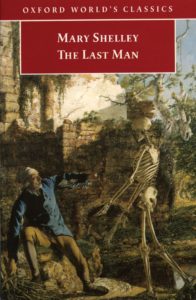
Mary Shelley, The Last Man (1826)
Shelley’s early novel of a 21st century world scrubbed nearly clean by bubonic plague was introduced as if it were merely a collection of prophetic writings that she found and compiled into a novel. Her contemporaries hated it. “It’s as if the critics were trying to annihilate with their rhetoric the very possibility of writing a novel on this subject,” wrote Morton D. Paley. “The author’s gender was of course not spared.” It was described as “a sickening repetition of horrors,” and “the offspring of a diseased imagination, and of a most polluted taste” . . . which should make any modern reader excited to pick it up. Good thing time goes on (for now).

Sandra Newman, The Country of Ice Cream Star (2014)
In post-pandemic Massachusetts, cabals of children run wild—children being the only humans left, as everyone now dies from a disease called “posies” by the age of 20. Unless, that is, our young heroine Ice Cream, can track down the cure. This is a big, difficult, and ambitious novel told in an invented apocalyptic language—it may not be for everyone, but for me it cements Newman’s status as an underrated genius.

Max Brooks, World War Z (2006)
Everyone’s favorite metafictional zombie apocalypse novel by Mel Brooks’ son, whose framing device—Brooks as agent of the United Nations Postwar Commission and his own actual/fictional survival guide, interviewing survivors—give it a polyphonic resonance. Don’t judge it by the movie, which takes serious liberties, and is not great.
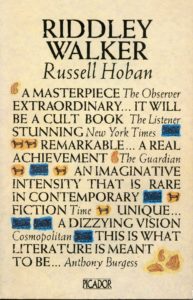
Russell Hoban, Riddley Walker (1980)
This classic, highly influential for its use of invented dialect, is set in England, some two thousand years after the end of civilization as we know it—when what society is left is uncomfortably reliant on “Punch & Pooty” shows. A layered, Joycean masterpiece that is as much about the power of story and myth as it is about the end of the world and everything after.

Hayao Miyazaki, Nausicaä of the Valley of the Wind (1994)
All right, technically this is a manga series, but I have it as a box set, and I’m counting it. I love Miyazaki’s post-apocalyptic world—most of the world is covered in toxic forest, known as the Sea of Corruption, which is itself overrun by giant, mutant insects, and which is encroaching—and his heroine, a curious princess turned battle captain with a deep respect for the natural world, corrosive as it may be.

Waubgeshig Rice, Moon of the Crusted Snow (2018)
It’s almost winter, and on the reservation of a small Anishinaabe community in northern Ontario, the power has gone out. Not just the power either, but the phones and the internet, resulting in full isolation. And it’s cold. Then the outsiders begin to appear. Fear and chaos reign, as Evan Whitesky, father of two, looks to the past, to tradition, to try to rebuild his community’s future. Chilling in more ways than one.

Edan Lepucki, California (2014)
Lepucki’s debut is probably most famous for being the book Stephen Colbert made famous, but it’s also a beguiling novel about love at the end of the world—though we never really learn what exactly tipped our present into this factionalized and urine-coated future. Could be anything, I guess.

Justin Cronin, The Passage (2010)
One of the best and biggest contemporary vampire novels is also one of the best and biggest apocalypse novels. It all starts in a lab, in which a virus meant to create super soldiers actually creates a plague of monsters—93 years later, the humans left huddle in colonies, hiding from the hunters outside the walls. But can the world actually be saved after all?

Anna North, America Pacifica (2011)
Some 70 years from now, North America is frozen. The survivors of the latest Ice Age are clustered on a Pacific island; only the eldest remember life on the mainland. But when her mother goes missing, Darcy has to uncover the secrets of the old world in order to parse the disruptions of the new.

Pierre Boulle, tr. Xan Fielding, Planet of the Apes (1963)
You don’t find out that Planet of the Apes is a post-apocalyptic novel, and not just a science fiction novel about another world, until the end of the book. (Sorry for not warning you about this spoiler, but look, you had almost 60 years.) What was the cause? Oh, laziness, really…

Megan Hunter, The End We Start From (2017)
Parenthood is a kind of apocalypse, yes, but—well, so is an underwater London. No food, no power, no internet; society begins to break down, but even this can barely distract a new mother from the magic of her child. Hunter’s sparse novel asks what to make of the first year of a life (and the first year of motherhood) at the end of the world.

Samuel R. Delany, Dhalgren (1975)
Is it actually a post-apocalypse through which our one-shoed protagonist drifts? Or are we dealing with a different reality entirely? Either way, it has the feeling of a land gone to seed, with bombed-out, disconnected cities, enormous red suns, inexplicable, endless fires. And either way, it is one of the weird greats, a widely influential and difficult—even impenetrable—cult classic.

Ursula K. Le Guin, Always Coming Home (1985)
“The people in this book might be going to have lived a long, long time from now in Northern California,” is how this book begins, in slippery Le Guin fashion. The apocalypse in Always Coming Home happened so long that none among the Kesh remember it—not even their songs know what caused it. Mostly, what’s left is styrofoam. This is not a straight narrative, but a realistic anthropological study of a fictional people, the Kesh, compiled and annotated by a researcher named Pandora. In some ways, it is a minor work in Le Guin’s oeuvre, but a fascinating one.

David Brin, The Postman (1985)
The book starts sixteen years after the apocalypse (“It hardly mattered anymore what had done it—a giant meteorite, a huge volcano, or a nuclear war. Temperatures and pressures swung out of balance, and great winds blew.” Much has changed for the survivors, but one thing has not: the authority conferred by a uniform. Or so discovers Gordon Krantz (aka Kevin Costner, if you’re one of the 8 people who saw the movie adaptation), a wanderer and one-time drama student who dons a uniform and mail sack found in an abandoned Postal Service truck and begins to play the role of an officer of the “Restored United States of America,” bringing hope to a populace trying to pull itself back from the brink.
By the way, David Brin had something to say about Donald Trump’s recent attacks on the USPS. “We are in the middle right now of an attempted worldwide oligarchic push to reinstall feudalism, the dismally-failed governance model that dominated 99 percent of societies on six continents for 6,000 years,” he told EW. “The Postman, both the movie and the book, talk about how essential it is for us to remember the things that knit us together. Small town America is especially coming to realize that really the post office is the center of town, but will they realize it in time to make a difference? I don’t think Trump cares any more if the Republican party is torched in November. I think chaos is the goal.”

Peter Heller, The Dog Stars (2012)
In this surprisingly uplifting post-apocalypse novel, a contagious disease called “The Blood” has wiped out most of civilization and left those who remain desperate and territorial (not to mention six feet apart from one another). “”The ones who are left are mostly Not Nice,” says Hig, our gentle hero. Hig lives in an old airplane hangar with his dog and grunty friend Bangley, who guards the perimeter, but after hearing a strange dispatch on the radio, he eventually goes out in search of other survivors, a final grasp at a better life.

Lidia Yuknavitch, The Book of Joan (2017)
In 2049, the world has been destroyed by global warming and war, and what humans are left orbit their one-time home in a colony called CIEL, led by the tyrannical Jean de Men, drawing whatever they can from the rock via “invisible technological umbilical cords.” One woman on CIEL, who will soon turn 50 and therefore be determined unnecessary and euthanized, tells the story of Joan of Dirt (for this is a riff on the Joan of Arc story), who is trying to save the world.

Lauren Beukes, Afterland (2020)
In Beukes’ fifth novel, it is 2023, and a pandemic has left fewer that 1% of the world’s male population alive. One of these is Cole’s 12-year-old son, Miles, whom Cole must protect at all costs—considering what nefarious minds, like her sister’s, might do with a boy immune to the virus—and so they go on the lam, Miles going as Mila, hoping to get home to Johannesburg. Like all of Beukes’ novels, it is fun, smart, and slightly sickening.

Angela Carter, Heroes and Villains (1969)
Years post-nuclear war, the world has forested over its wounds, animals run free, and humanity has split into factions, if not variations: the Professors, the Soldiers, the Barbarians, and the Out People. Marianne is one of the Professors, and lives in a literal ivory tower with her father—until she sneaks out to experience life as a Barbarian. As you might expect from Carter, this is a terse, mythic, twisted take on the end of days.

George R. Stewart, Earth Abides (1949)
One of the classics of the genre, in which a student, Ish, emerges from a period of isolation and illness—he was bitten by a diseased rattlesnake—and steps back into the world to find almost no one left alive in it. But humans, like any invasive species, will find a way, and so Ish meets Em, and they build a community of survivors, new and old—but instead of rebuilding the world they knew, they must watch as the younger generation adapts and begins to build a new society based on the world that is left.
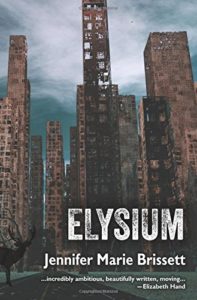
Jennifer Marie Brissett, Elysium (2014)
In this surreal novel, two characters at the end of a world destroyed switch genders, roles, and relationships to one another as their lives are repeatedly rebooted by a mysterious—and corrupted—atmospheric computer program, which is looking (maybe) for a savior.

Peng Shepherd, The Book of M (2018)
This novel includes one of the stranger epidemics in apocalypse fiction: the Forgetting, which has devastated the world by separating those afflicted from their shadows—and their memories, which causes them to behave erratically, even violently. As society breaks down, Ory and Max (one shadowless, one not) try to find answers, and each other.
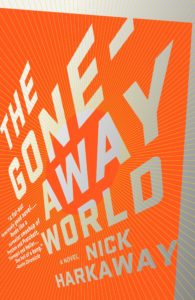
Nick Harkaway, The Gone-Away World (2008)
If you like your post-apocalypses a little ludicrous, you may enjoy Harkaway’s take, in which the “Go-Away War” has left three-quarters of the Earth’s population dead—or, more specifically, “gone-away,” i.e. still there, but stripped of information—until it comes in contact with a survivor’s mind, that is. Our hero is a kung fu trucker named Gonzo, and of course, he must save what’s left of the world.
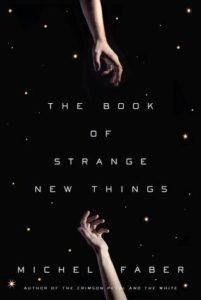
Michel Faber, The Book of Strange New Things (2014)
In this novel, a pastor goes to another planet to spread Christianity, leaving his wife at home; what results, among other things, is that the apocalypse in this novel is telegraphed to the protagonist at a distance, through increasingly alarming and unbelievable missives, even as he finds himself drawing further away from the life he used to know and the woman he used to love.

Daniel H. Wilson, Robopocalypse (2011)
For a little relief from nuclear war and pandemics, enter the robopocalypse—which, by the way, is exactly what it sounds like. It begins, of course, with a brilliant scientist and a sentient computer program, Archos, which kills its creator and decides that its purpose for being is to save the planet from the human race. Archos spreads to machines around the world, which kill or enslave humans—until a few begin to fight back. Another breath of fresh air: this novel is told from the other side of the apocalypse, a reminder that these things can be reversed, at least sometimes.

Pat Frank, Alas, Babylon (1959)
In this classic of nuclear holocaust fiction, when much of the United States is destroyed by the Soviet Union, one small Florida town survives, adapting to their new lives in a radioactive wasteland.

M. R. Carey, The Girl with All the Gifts (2014)
When this novel begins, it’s about a decade after the zombie apocalypse has left only a handful of uninfected humans in Britain—the rest are dead or infected, “empty houses where people used to live” known as “hungries.” It’s been long enough, though, for there to be a second generation of hungries: children who are preternaturally smart, absurdly strong, and capable (maybe) of human empathy. Unless they smell a human, that is. Then they want to eat it. The human scientists who are left are torn: try to crack open the eponymous Melanie’s brain to figure out how it works? Or treat her like a child and hope she can lead the world back to humanity that way?

Robert R. McCammon, Swan Song (1987)
A horror novel and an apocalypse novel in one—as if surviving nuclear holocaust wasn’t enough, now there’s a demonic entity known as The Man with the Scarlet Eye, aka Doyle, running around. Typical.

Sarah Pinsker, A Song for a New Day (2019)
Oh, weird, a novel in which a string of terrorist attacks, mass shootings, bombings, and then a pandemic, has resulted in widespread fear, consolidation of corporate power, and the end of all public gatherings. So unrealistic, amirite? Instead of Zoom, though, Luce and her band-mates have to contend with StageHolo, basically a holographic pay-per-view for concerts, and their talent scout Rosemary, who never really knew the world Before. Like all the best apocalyptic fiction, this is actually a book about human connection—the fact that it’s also a cool, queer rock and roll novel is just a bonus.

C.A. Fletcher, A Boy and His Dog at the End of the World (2019)
Just what it says on the tin. The boy (Griz) and the dog (Jip) are among the survivors after the “soft apocalypse” known as the Gelding, which neutered most of the world. When Griz’s other dog (Jess) is stolen, Griz and Jip must make a rescue mission through the ruins of Scotland.



